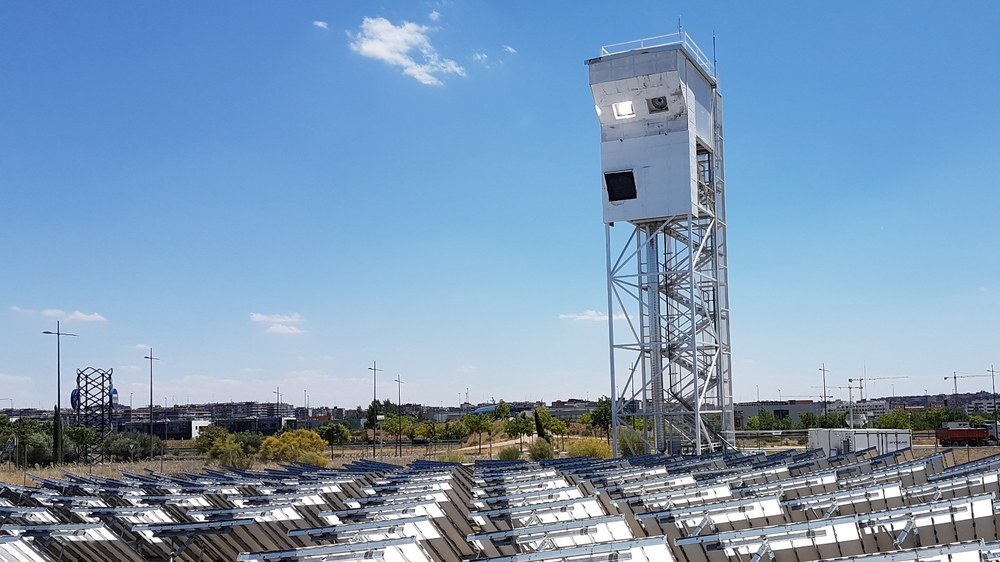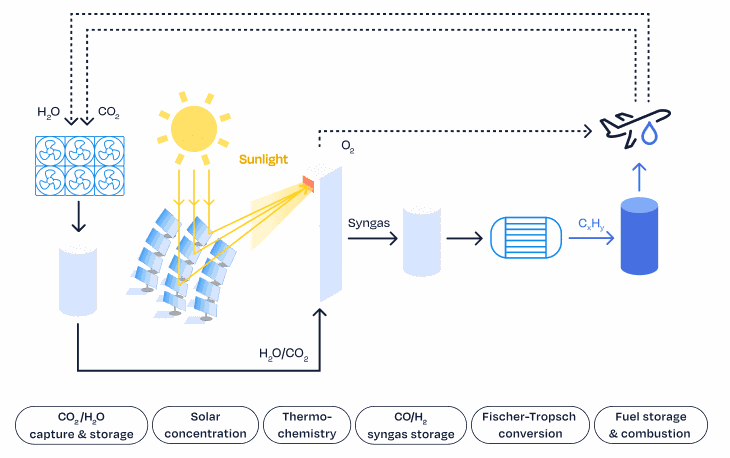SUN-to-LIQUID II

Fuels from concentrated sunlight
Duration: 1.11.2023 – 31.10.2027
The European Green Deal aims at a 90 percent reduction in transport-related greenhouse gas emissions by 2050 which requires large volumes of renewable liquid fuels especially for aviation. Co-funded by the EU and Switzerland, the European research project SUN-to-LIQUID II addresses this challenge. Leading institutions from academia and industry aim to demonstrate scalability and high efficiency in the production of sustainable hydrocarbon fuel from water, CO2 and concentrated sunlight via high-temperature chemical conversion.
What is SUN-to-LIQUID II about
The transportation sector will play an important role in the transition to a society living on 100 percent renewable energy. Two key challenges towards achieving this target relate to (i) an increased feedstock basis for renewable fuel production and (ii) the long-term development of sustainable fuel technologies for aviation.
While electrification, and likely also hydrogen, will be very important for the decarbonisation of transportation, there will still be a continued need for energy-dense liquid hydrocarbon fuels, especially for aviation and shipping. First-generation biofuels cannot meet the required volumes, due to availability and sustainability constraints. Hence, scalable technologies will be required to meet the longer-term fuel demand. Solar radiation as energy source is suitable for this, as it is the most scalable form of renewable energy.
SUN-to-LIQUID II aims to develop a set of versatile technologies for solar fuel production from water and CO2, such as:
- an improved high-flux solar concentration system for applications using high-temperature process heat,
- efficient “solar-thermochemical” fuel production, i.e. a sunlight-driven high-temperature chemical conversion process, using novel 3D-printed materials in the solar reactor for the reduction-oxidation processes,
- heat exchange and heat recovery concepts to further improve the efficiency of high-temperature conversion processes.
The primary objective of SUN-to-LIQUID II is to increase the solar reactor energy efficiency to more than 15 percent. To achieve this, the effective radiative absorption will be improved using 3D-printed redox materials with optimised structure and by recovering sensible heat during the temperature swing redox process. This should optimise the process in which oxygen is split off from water vapor and carbon dioxide by a chemical reaction, bringing key advancements from laboratory-scale research in redox material and heat recovery to validation in an industrially relevant environment.
Besides, this project wants to provide evidence for cost-effective more than 80 percent greenhouse gas emission reduction especially for aviation. The technical scalability to production potentials should exceed the projected demand.
The ultimate output should be a step-change technology advancement. SUN-to-LIQUID II taps into a virtually unlimited resource of sustainable fuel production by developing the technology and roadmap to produce high-quality renewable liquid fuel directly from water, CO2 and concentrated solar energy.
The partnership
The SUN-to-LIQUID II consortium consists of six partners from five European countries (Germany, Spain, Switzerland, Netherlands, and France), under the coordination of Bauhaus Luftfahrt e. V. This partnership between research institutes and industry aims to bridge the gap between research and industrial applications in high-temperature sunlight-driven chemistry.
DLR is leading the development of the next generation solar receiver-reactor with integrated heat recovery and advances the solar concentrator and plant operation together with IMDEA Energía. The receiver-reactor will be installed at the solar concentrator facility at the IMDEA Technology Park in Móstoles, Spain. Industrial partners are HyGear BV, Synhelion SA and L-up.
The project is built on the preceding Horizon2020 project SUN-to-LIQUID which successfully demonstrated on-sun solar-thermochemical fuel production on a 50-kW scale.
More information on the project website:
Project | SUN-to-LIQUID II |
|---|---|
Duration | 1.11.2023 – 31.10.2027 |
Project participants |
|
Funding |



